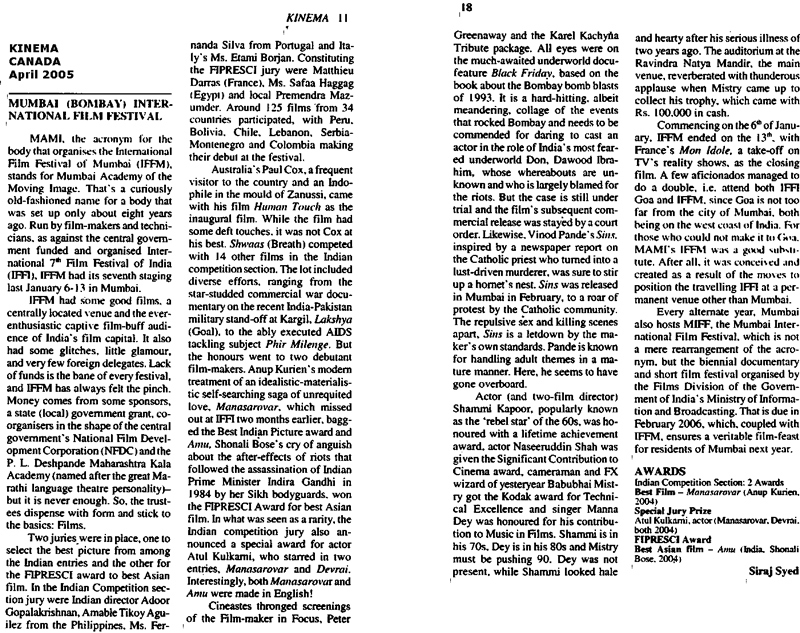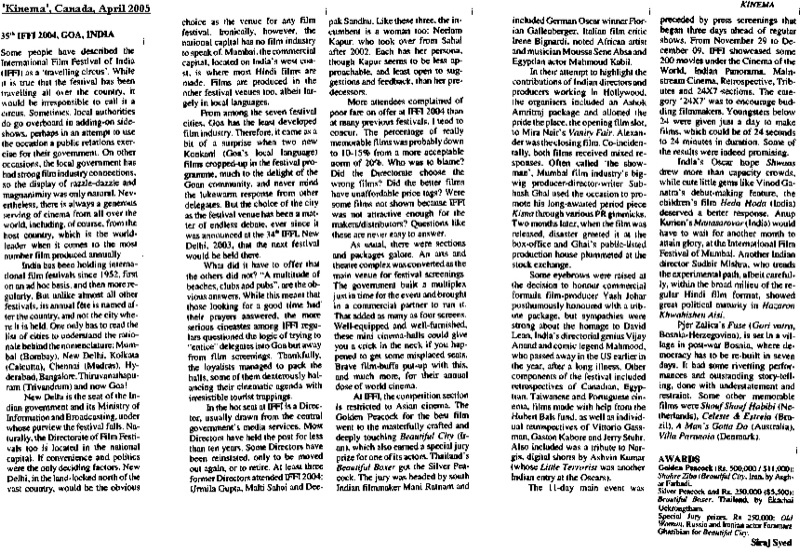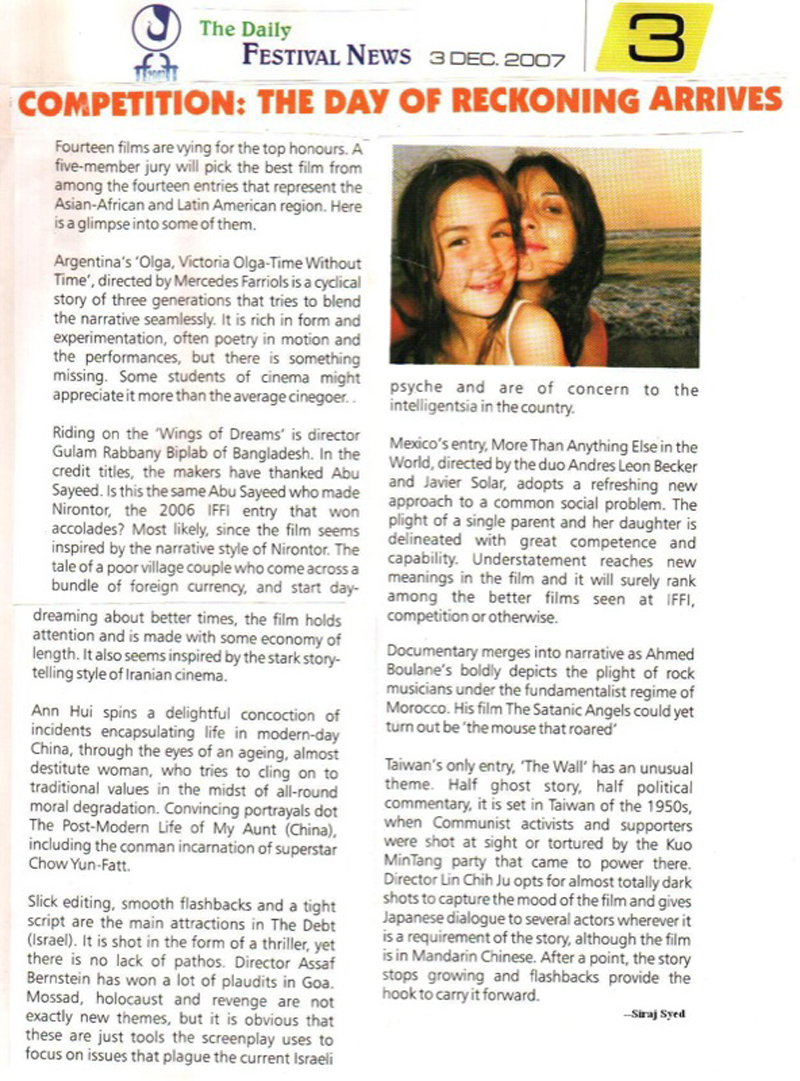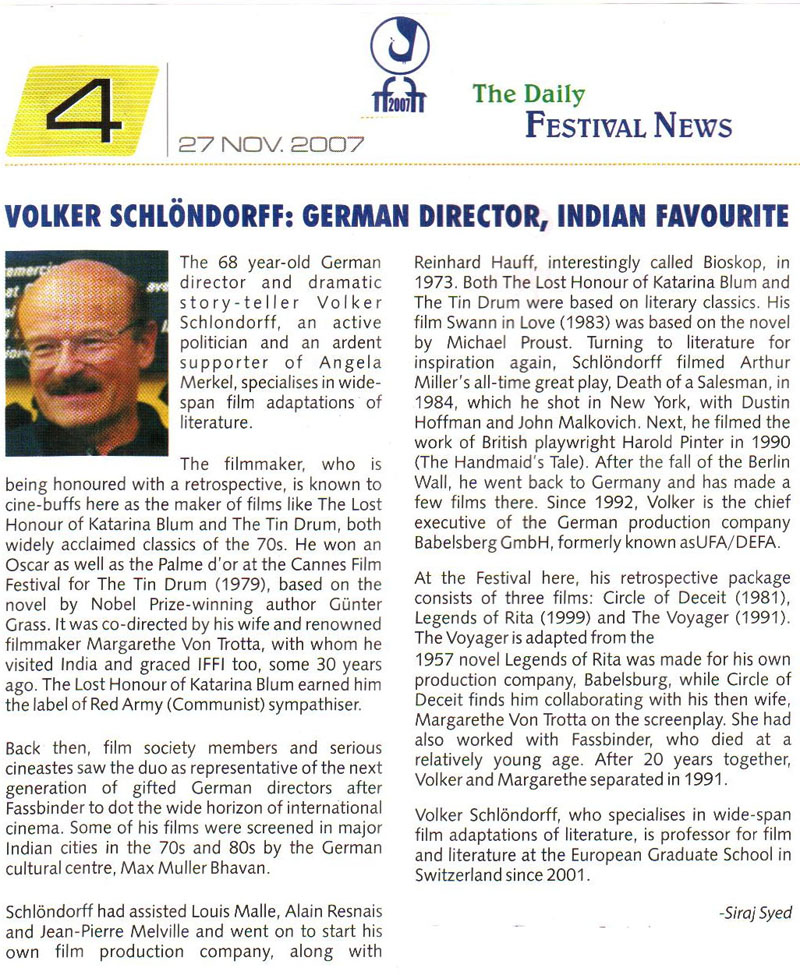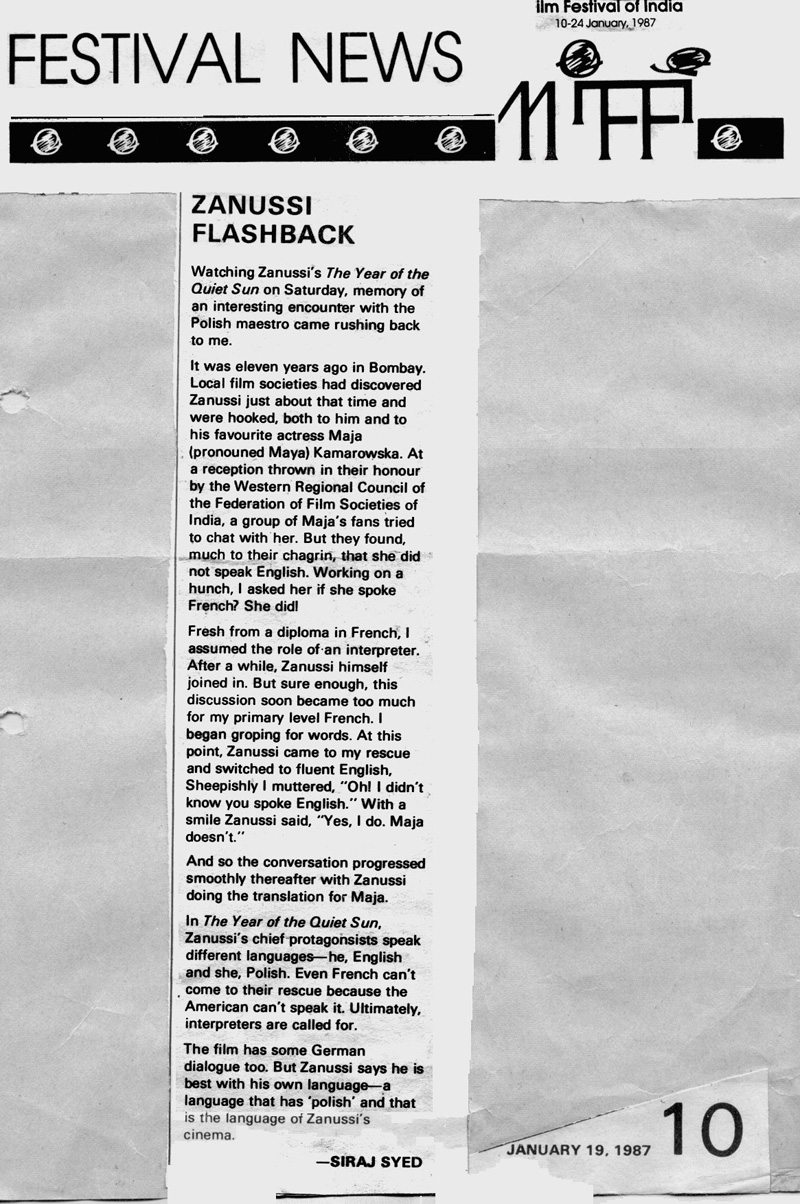|
|
||
|
Pro Tools
FILMFESTIVALS | 24/7 world wide coverageWelcome ! Enjoy the best of both worlds: Film & Festival News, exploring the best of the film festivals community. Launched in 1995, relentlessly connecting films to festivals, documenting and promoting festivals worldwide. Sorry for the disruptions we are working on the platform as of today. For collaboration, editorial contributions, or publicity, please send us an email here. User loginActive Members |
Siraj SyedSiraj Syed is the India Correspondent for FilmFestivals.com and a member of FIPRESCI, the International Federation of Film Critics. He is a Film Festival Correspondent since 1976, Film-critic since 1969 and a Feature-writer since 1970. He is also an acting and dialogue coach. @SirajHSyed  Dunkirk, Review by Siraj Syed: 300,000 stranded soldiers--Between certain death and uncertain rescue, a movie to cling on to
Dunkirk, Review by Siraj Syed: 300,000 stranded soldiers--Between certain death and uncertain rescue, a movie to cling on to It really happened. Give or take a few details, it really happened. Between 300,000 and 400,000 British troops were evacuated by British vessels from a beach in Dunkirk, France, in May 1940, amidst German submarine and aerial attacks. Dunkirk, the movie, is a visual roller-coaster on land, sea and air, where thrills are interwoven with chills, and dizzy heights blend with sinking feelings. It took a Christopher Nolan to reassemble and relive the dark events in his most experimental film so far, eschewing VFX and CGI in favour of reality, in an age when special effects rule the roost. Hitler’s army has swept across France and Belgium. In France, it is knocking at the doors of the perimeter in Dunkirk, which is the last bastion, protected by the French. A group of five British soldiers are caught in German fire near the perimeter; only one, Tommy, manages to escape to the beach. The beach is a sordid sight. Corpses are strewn across the sand. One man is burying a dead soldier. Thousands of battle-weary soldiers are standing in queue. Many of them are seriously wounded and are being carried on stretchers. Tommy and that man, whose name, he gathers, is Gibbons, carry a wounded soldier on a stretcher to a ship that is just about to leave for England, less than an hour away. They manage to reach in the nick of time. Only British soldiers are taken on board; French are not allowed and asked to leave by their own ships. After the man on the stretcher has been laid down, the two are asked to get off, since there is a huge queue of soldiers waiting for their turn. The two decide to hide on the lower external flanks of the ship, in hope of getting aboard once it is out at sea. Stranded soldiers are provided minimal air support, since Winston Churchill’s Britain wants to preserve its planes for when the battle comes to its shores. Nevertheless, three Spitfire aircraft fly to Dunkirk on mission Fortis and render exemplary service. Meanwhile, vessel after vessel is hit by air or U-boat fire, and only burning wreckages and oil spills remain, shattering the homecoming dreams of thousands. Desperate, the British War Office issues orders to commandeer small civilian boats and send them to Dunkirk. Being small, these boats can reach almost up to the beach and save the soldiers from having to wade into sea in shoulder deep water. One such boat belongs to Dawson, who volunteers to navigate it himself, from Dover to Dunkirk and back, with the help of his son Peter and teenage helping hand, George. Dawson had lost his other son, a Hurricane pilot, in the early days of the war. What follows is a heart-throbbing account of hope in hopeless situations, and the survival instinct at its best and worst. It has been revealed that writer-director Nolan wrote the first draft around 1990. We are not aware whether he had seen the 1958 British film version of the same name that had more box-office collections worldwide than at home. We are also not aware whether his minimalistic approach to a gargantuan project is a result of the sensitivities of his first draft being written 25 years before he started shooting, but we are told on authority that he used plastic cut-outs to give the impression of a much larger soldier count, and reconditioned three real WWII Spitfires, using them to stage the realistic aerial dog-fights. Noticeably, he has avoided any back-stories, except the bit about the Dawsons and George. Using a non-linear narrative, he comes back to the same planes in mid-air combat after one of them is downed and another is shown landing on water. You have to keep a keen eye on the objects and faces if you want to keep up with the back-and-forth narrative, for some vessels look similar and so do planes, pilots and soldiers. Was the non-linear story-telling really necessary? As Nolan has said himself, he was experimenting. War strategy is discussed only by Commander Bolton and Colonel Winnant, which is correct in terms of hierarchy and well shot. But when they do it in a similar manner for the third time, you wonder whether Nolan could have done it differently. Two examples of ‘doing it differently’ come in the shape of the leaflets dropped by German planes outside the perimeter, and the newspaper headline in the penultimate shot of the film. Those are in keeping with the film’s no back-story, no narration, no montage, no detailed characterisation, no war-room, no German soldiers in any frame, approach. Churchill’s speech being included is in order. How could Nolan avoid that, and why would he? Dunkirk is, in some ways, an immersive, staged documentary: The 65 mm large format and IMAX cameras, the IMAX hand-held, the mounting of cameras on the cockpit of aeroplanes in flight using snorkel lenses, detailing of the flooding shots from reverse angles, the water as an element that catches fire every time a bomb explodes, and carries deadly oil. I know it is 1940, but I do feel that the air-combat scenes are a bit longer than necessary and not really as exciting as Nolan could have made them. On the sea too, soldiers getting on to one vessel, the vessel being bombed or hit by gunfire, the soldiers clinging on to dear life till another vessel is available, then that vessel is hit, is also another routine that, though brilliantly done, is repetitive. TV actor Fionn Whitehead (Tommy) has a vulnerable and expressive face. Tom Glynn-Carney (debut) comes from theatre and TV; as Peter, he beautifully underplays. Michael Caine provides voice for the Fortis leader, while Tom Hardy (Tinker Tailor Soldier Spy, The Dark Knight Rises, Mad Max: Fury Road) and Jack Lowden (’71, Tommy’s Honour, Denial) are cast as the two Spitfire pilots. Very little is seen of them, with masks covering their faces. Hardy manoeuvres the suspenseful descent of his aircraft, with a dead propeller, and earns empathy in the process. Another debutant, singer Harry Styles, plays Alex, who joins Tommy and Gibbons in their desperate getaway attempts. He has an attractive presence. Mary Queen of Scots, The Devil’s Harvest and Interlude in Prague actor Aneurin Barnard makes a suitably nervous Gibbons. As the gutsy and committed patriot, Dawson, Mark Rylance shines. As George, Barry Keoghan (Mammal, Trespass Against Us, The Killing of a Sacred Deer) will moisten many an eye. Bolton and Winnant are enacted by Kenneth Branagh (Henry V, Sleuth, Thor) and James D’Arcy (Age of Heroes, Hitchcock, Agent Carter). The two are in charge of the rescue operation and Britain’s tactics and war moves are known only to them. As mere pawns in the operation, they have to cling to straws, as is effectively conveyed in their exchanges at the pier. Branagh oozes dignity and hope, while D’Arcy conveys practicality and concern. For framing the angles of air combat, a small boat juxtaposed against a huge mine-sweeper, the action inside a cramped trawler, and so many challenging scenes, Hoyte van Hoytema (Tinker Tailor Soldier Spy, Spectre, Interstellar) can expect major honours for his cinematography. Composer Hans Zimmer sets off on an ominous beat as the stretcher is carried towards the ship, and then develops the beat progressively. In the later portion, he tends to go overboard. Lee Smith edits the film with finesse and artistry, and, at least in the first half, cuts are silky smooth and almost invisible. Most of the 106 minutes sail past before you realise the pace. This is history, and portraits of various shades of human nature, throbbing under the skin of a war film. It is not about victory, but escape being a strategic victory. It is also about Hitler’s one big mistake: depending upon submarines and Messerschmitts to wipe out the withdrawing troops, and saving his tanks and troops for other fronts. Comparisons with other war films will be pointless, because there will be more counts of differences than similarities. The Longest Day, about Normandy, comes to mind, but that was too spread out, had five directors (two of them uncredited) and an array of stars. Except for two or three things that he could have probably done differently or better, Christopher Nolan (three Batman movies, Inception, Interstellar) has had a great landing at Dover. Along with the 300,000+ British troops brought home from Dunkirk, he might have just about brought along two or three Academy Awards as well. Taking a cue from the triptych segmentation of the film, do not waste one hour, one day or one week deciding. Head for Dunkirk, now. Rating: **** Trailer: https://www.youtube.com/watch?v=F-eMt3SrfFU 30.07.2017 | Siraj Syed's blog Cat. : Aneurin Barnard Barry Keoghan Christopher Nolan Dover Dunkirk Fionn Whitehead Hans Zimmer Harry Styles Hoyte van Hoytema Jack Lowden James D’Arcy Kenneth Branagh Lee Smith Mark Rylance Messerschmitt Michael Caine perimeter Spitfire Tom Glynn-Carney Tom Hardy Winston Churchill World War II WWII Hollywood
|
LinksThe Bulletin Board > The Bulletin Board Blog Following News Interview with EFM (Berlin) Director
Interview with IFTA Chairman (AFM)
Interview with Cannes Marche du Film Director
Filmfestivals.com dailies live coverage from > Live from India
Useful links for the indies: > Big files transfer
+ SUBSCRIBE to the weekly Newsletter DealsUser imagesAbout Siraj Syed Syed Siraj Syed Siraj (Siraj Associates) Siraj Syed is a film-critic since 1970 and a Former President of the Freelance Film Journalists' Combine of India.He is the India Correspondent of FilmFestivals.com and a member of FIPRESCI, the international Federation of Film Critics, Munich, GermanySiraj Syed has contributed over 1,015 articles on cinema, international film festivals, conventions, exhibitions, etc., most recently, at IFFI (Goa), MIFF (Mumbai), MFF/MAMI (Mumbai) and CommunicAsia (Singapore). He often edits film festival daily bulletins.He is also an actor and a dubbing artiste. Further, he has been teaching media, acting and dubbing at over 30 institutes in India and Singapore, since 1984.View my profile Send me a message The Editor |




